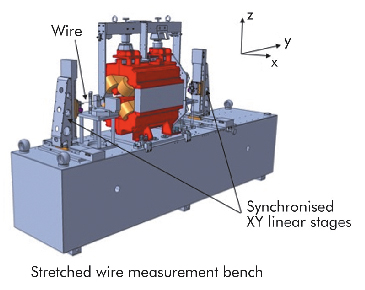- Home
- Users & Science
- Scientific Documentation
- ESRF Highlights
- ESRF Highlights 2010
- Accelerator and X-ray Source
- A versatile stretched wire bench for magnetic measurements of accelerator magnets
A versatile stretched wire bench for magnetic measurements of accelerator magnets
A number of accelerator magnets (high gradient quadrupoles and new short sextupoles) are needed for the upgrade of the accelerator. These magnets need to be fully magnetically characterised. In such measurements, the field integral inside the aperture of the magnet is analysed in terms of integrated multipoles (harmonic analysis); the main integrated multipole must be resolved with a relative accuracy better than 10–4. An accurate determination of the magnetic axis of the magnet is also important. This must coincide with the electron beam axis with an error lower than 50 micrometres when installed in the accelerator. This needs dedicated fiducialisation tasks to transfer the magnetic axis to survey monument installed on the magnet. A well-established technique is based on long rigid rotating coils inserted in the aperture of the magnets. A large majority of quadrupole and sextupole magnets have been characterised with this method. However, in the case of magnets with small internal bore or long devices, the method becomes impractical due to the reduced rigidity of the coil.
 |
|
Fig. 159: ESRF stretched wire bench configured for the measurement of a quadrupole magnet. |
Another approach has been developed at the ESRF. It is based on a Cu-Be or Ti-Al wire stretched between two synchronised XZ stages (Figure 159). This concept is not new, but is re-examined here on the basis of modern motion controls and instrumentation. The movable wire and a fix return part form a loop connected to a low noise voltmeter. This is moved at a constant speed (10 to 40 mm/s) along various paths built up from successive straight and circular segments while triggering the voltmeter at constant path length intervals. The circular motion as used with a conventional coil for harmonic analysis has become a particular case. The first tests carried out in this mode on a quadrupole magnet (Figure 159) show that the stretched wire concept is fully usable for the accurate characterisation of conventional accelerator magnets. All linear stages involve DC motors operated in closed loop with encoders. From laser interferometer measurements, a correction grid is implemented in the motor controller to achieve a positioning accuracy smaller than 5 µm in a circle with a radius of 5 cm. As the design of the measuring bench allows it to be adapted to any magnet aperture, it was recently used for the accurate field adjustment of permanent magnet steerers to be installed in future canted undulator sections. It also offers new opportunities for the field integral magnetic measurements of undulators. In particular, compared to benches based on solid coils that are commonly used, it provides measurements with higher spatial resolution that should allow more efficient corrections on small gap devices such as in-vacuum undulators.



